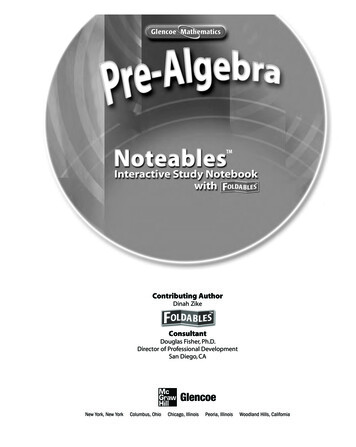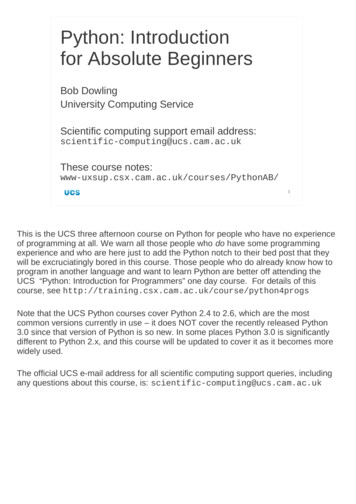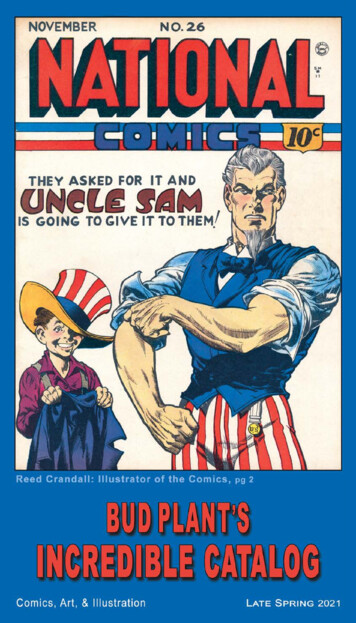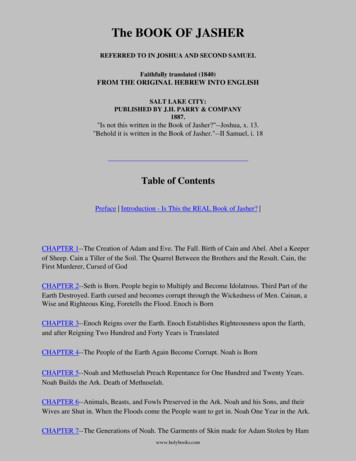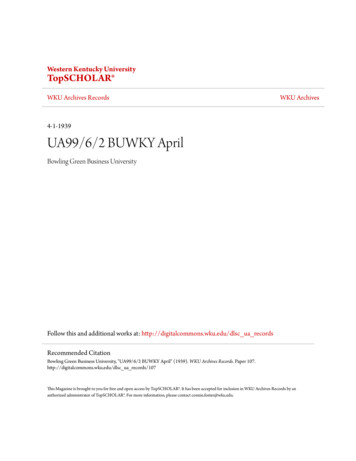
Transcription
AuthorDinah Zike, M. Ed.Educational ConsultantSan Antonio, Texas
For more information on Foldables or to orderDinah Zike’s Big Book of Math, contact:Dinah-Might Adventures, LPP.O. Box 690328San Antonio, Texas 78269(800)99-DINAHwww.dinah.comCopyright by The McGraw-Hill Companies, Inc. All rights reserved.Except as permitted under the United States Copyright Act, no part ofthis publication may be reproduced or distributed in any form or by anymeans, or stored in a database retrieval system, without prior writtenpermission of the publisher.Send all inquiries to:Glencoe/McGraw-Hill8787 Orion PlaceColumbus, OH 43240-4027ISBN 0-07-869384-5Printed in the United States of America.1 2 3 4 5 6 7 8 9 10 045 09 08 07 06 05 04
Table of ContentsLetter from Dinah Zike . . . . . . . . . . . . . . . . . . . . . ivIntroduction to FoldablesWhy use Foldables in mathematics? . . . . . . . . . . . 1Foldable Basics . . . . . . . . . . . . . . . . . . . . . . . . . . . 2Selecting the Appropriate Foldable . . . . . . . . . . . . 4Folding InstructionsBasic Foldable Shapes . . . . . . . . . . . . . . . . . . . . . . 6Bound Book . . . . . . . . . . . . . . . . . . . . . . . . . . . . . . 7Two-Tab Book . . . . . . . . . . . . . . . . . . . . . . . . . . . . 8Three-Tab Book . . . . . . . . . . . . . . . . . . . . . . . . . . . 9Layered-Look Book . . . . . . . . . . . . . . . . . . . . . . . 10Four-Tab Book . . . . . . . . . . . . . . . . . . . . . . . . . . . 11Vocabulary Book . . . . . . . . . . . . . . . . . . . . . . . . . 12
FROM DINAH ZIKEDear Teacher,In this book, you will find instructions for making Foldables as well as ideas on how to usethem. They are an excellent communication tool for students and teachers.National Math Standardsand Communication SkillsThe Principles and Standards for School Mathematics, published by the NationalCouncil of Teachers of Mathematics (NCTM) in 2000, stress the importance ofcommunication skills in a strong mathematics program. Not all students willbecome mathematicians, engineers, or statisticians, but all students need to be ableto think, analyze, and problem solve using skills acquired through the study ofmathematics.Throughout their lives, students will be called upon to be literate in mathematics—personally and professionally. They will need to have a basic understanding ofnumbers, operations, and quantitative reasoning; patterns, relationships, andalgebraic thinking; geometry; measurement; and probability and statistics to solvereal-life problems involving finances, chance, design, science, fine arts, and more.Furthermore, students must be able to share the results of their use of mathematicsusing various forms of oral and written communication. Foldables are one of manytechniques that can be used to integrate reading, writing, thinking, organizing data,researching, and other communication skills into an interdisciplinary mathematicscurriculum.Who, What, When, WhyYou probably have seen at least one of the Foldables featured in this book used insupplemental programs or staff-deveopment workshops. Today, my Foldables areused internationally. I present workshops and keynotes to over fifty thousand teachers and parents a year, sharing the Foldables that I began inventing, designing, andadapting over thirty years ago. Around the world, students of all ages are usingthem for daily work, note-taking activities, student-directed projects, forms ofalternative assessment, math journals, graphs, charts, tables, and more.Foldables become a visual and kinesthetic tool to help students communicate whatthey learn, observe, and experience in math. I hope you enjoy making Foldables apart of your math classroom!iv
INTRODUCTION TO FOLDABLESWhy use Foldables in mathematics?When teachers ask me why they should take time to use the Foldables featured in this book, Iexplain that they. . . quickly organize, display, and arrange information, making it easier for students to graspmath concepts and master skills. . . result in student-made study guides that are compiled as students listen for main ideas,read for main ideas, and work their way through new concepts and procedures. . . provide a multitude of creative formats in which students can present projects, research,and computations instead of typical poster board or math fair formats. . . replace teacher-generated writing or photocopied sheets with student-generated print. . . incorporate the use of such skills as comparing and contrasting, recognizing cause andeffect, and finding similarities and differences into daily work and long-term projects. Forexample, these Foldables can be used to compare and contrast student explanations andprocedures for solving problems to the explanations presented by other students andteachers. . . continue to “immerse” students in previously learned vocabulary and concepts, providingthem with a strong foundation that they can build upon with new observations,experiences, and knowledge. . . can be used by students or teachers to easily communicate data through graphs, tables,charts, models, and diagrams, including Venn diagrams. . . allow students to make their own math journals for recording main ideas, problem-solvingstrategies, examples, questions that arise during classwork, and personal experiences thatoccur during learning. . . can be used as alternative assessment tools by teachers to evaluate student progress or bystudents to evaluate their own progress. . . integrate language arts, the sciences, and social sciences into the study of mathematics. . . provide a sense of student ownership in the mathematics curriculum.1
INTRODUCTION TO FOLDABLESFoldable BasicsWhat to Write and WhereTeach students to write general information—titles, vocabulary words, concepts, questions, mainideas, and properties or theorems—on the front tabs of their Foldables. General information isviewed every time a student looks at a Foldable. Foldables help students focus on and rememberkey points without being distracted by other print.Ask students to write specific information—supporting ideas, student thoughts, answers toquestions, research information, computation steps, class notes, observations, and definitions—under the tabs.As you teach, demonstrate different ways inwhich Foldables can be used. Soon you will findthat students make their own Foldables and usethem independently for study guides and projects.With or Without TabsFoldables with flaps or tabs create study guides that students can use to self check what theyknow about the general information on the front of the tabs. Use Foldables without tabs forassessment purposes or projects where information is presented for others to view quickly.Venn Diagram used as a study guide2Venn Diagram used for assessment
INTRODUCTION TO FOLDABLESWhat to Do withScissors and GlueI don’t expect secondary students to bringglue and scissors to math class. Instead, Iset up a small table in the classroom andprovide several containers of glue,numerous pairs of scissors (sometimes tiedto the table), containers of markers andcolored pencils, a stapler, clear tape, andanything else I think students might needto make their Foldables. Don’t besurprised if students donate unusualmarkers, decorative-edged scissors, gelpens, stencils, and other art items to your publishing table.The more they make and use graphic organizers, the faster students become atproducing them.Storing GraphicOrganizers inStudent PortfoliosTurn one-gallon freezer bags into studentportfolios which can be collected andstored in the classroom. Students can alsocarry their portfolios in their notebooks ifthey place strips of two-inch clear tapealong one side and punch three holesthrough the taped edge.Have each student write his or her namealong the top of the plastic portfolio with apermanent marker and cover the writing with two-inch clear tape to keep it from wearing off.Cut the bottom corners off the bag so it won’t hold air and will stack and store easily.HINT: I found it more convenient to keep student portfolios in my classroom sostudent work was always available when needed and not “left at home” or “inthe car.” Giant laundry-soap boxes make good storage containers for portfolios.Let Students Use This Book As an Idea ReferenceMake this book available to students to use as an idea reference for projects, discussions, extracredit work, cooperative learning group presentations, and more.3
INTRODUCTION TO FOLDABLESSelecting the Appropriate FoldableDividing Math Concepts into PartsFoldables divide information and make it visual. In order to select the appropriate Foldable,decide how many parts you want to divide the information into and then determine whichFoldable best illustrates or fits those parts. Foldables that are three-dimensional also make thestudent interact with the information kinesthetically.For example, if you are studying the Properties of Equality you could choose a Foldable thathas five tabs (or sections). On the front tabs write the properties. Under the tabs, explain theproperties in words on one side and in symbols on the other side.Math Concepts Already Divided into PartsParts53AlgebraConceptProperties of Equalityparentheses, brackets,and bracesParts222equations and inequalities22numeric and algebraicexpressionsdomain and range3272properties of addition andmultiplicationLCM and LCDGeometryConceptcollinear and noncollinearcomplementary andsupplementary anglesparallel and perpendicular6translation, rotation,reflectiontypes of triangles4SSS, SAS, ASA, AAS23monomials, binomials,and trinomials6two types of special righttrianglestypes of quadrilaterals2powers and exponents2x-axis and y-axisStatistics and ProbabilityPartsConcept3mean, median, mode1Fundamental CountingPrinciple4Who, What, When,Where: Blaise Pascal2permutations andcombinations2upper quartile and lowerquartile2dependent andindependent events2probability and odds22odds in favor and oddsagainstmutually inclusive andexclusive eventsMath Concepts That Can Be Divided into PartsAlgebrawrite algebraic expressionsevaluate expressionssequence stepslist algebraic rulessolve equationsfind values for variables4Geometrydraw angles with a protractorclassify polygonsillustrate quadrilateralslist examples of prismsname ordered pairsgraph pointsStatistics and Probabilitydetermine ranges of setsinterpret scatter plotsdisplay data collected in plotsdraw models of combinations
INTRODUCTION TO FOLDABLESDividing Skills and Foldables into PartsReading, writing, and thinking skills can easily be used with Foldables. The following listsshow examples of skills and activities and a selection of Foldables divided into parts.Skills and Activities Divided into Parts1 PartFind the Main IdeaPredict an OutcomeNarrative WritingDescriptive WritingExpository WritingPersuasive Writing3 PartsVenn DiagramsKnow?-Like to Know?-Learned?Beginning, Middle, End2 PartsCompare and ContrastCause and EffectSimilarities and DifferencesOpposite Operations4 PartsWho, What, When, WhereWhat, Where, When, Why/HowAny Number of PartsMaking and Using TablesMaking and Using GraphsMaking and Using ChartsSequencing Data or EventsQuestioningFlow ChartsVocabulary WordsTimelinesConcept Webs or MapsFoldables Divided into Parts1 PartHalf BookFolded BookMatchbookBound Book3 PartsTrifold BookThree-Tab BookPyramid BookLayered-Look BookConcept Map with Three TabsAccordion BookLayered-Look BookSentence-Strip HolderFolded Table, Chart, or GraphPyramid MobileTop-Tab Book(three or more sheets of paper)2 PartsTwo-Tab BookPocket BookShutter FoldMatchbook Cut in HalfConcept-Map Book with Two Tabs4 PartsFour-Tab BookStanding CubeTop-Tab BookFour-Door BookAny Number of PartsCircle GraphConcept-Map BookVocabulary BookBound BookPocket Books5
FOLDING INSTRUCTIONSBasic Foldable ShapesThe following figures illustrate the basic folds that are referred to throughout the followingsection of this book.Taco FoldHot Dog FoldHamburger FoldBurrito FoldValley FoldShutter FoldMountain Fold6
FOLDING INSTRUCTIONS— 1-PART FOLDSBound Book1121. Take two sheets of 8 " 11" paperand fold each one like a hamburger. Placethe papers on top of each other, leavingone sixteenth of an inch between themountain tops.2. Mark both folds one inch from the outeredges.3. On one of the folded sheets, cut from thetop and bottom edge to the marked spoton both sides.234. On the second folded sheet, start at one ofthe marked spots and cut the fold betweenthe two marks.5. Take the cut sheet from step 3 and fold itlike a burrito. Place the burrito throughthe other sheet and then open the burrito.Fold the bound pages in half to form aneight-page book.457
FOLDING INSTRUCTIONS— 2-PART FOLDSTwo-Tab Book1. Take a folded book and cut up the valleyof the inside fold toward the mountain top.This cut forms two large tabs that can beused front and back for writing andillustrations.2. The book can be expanded by makingseveral of these folds and gluing themside-by-side.Use this book for data that occurs in twos, forexample opposite operations812
FOLDING INSTRUCTIONS— 3 -PART FOLDSThree-Tab Book1. Fold a sheet of paper like a hot dog.12. With the paper horizontal, and the fold of thehot dog up, fold the right side toward thecenter, trying to cover one half of the paper.2NOTE: If you fold the right edge over first,the final graphic organizer will open andclose like a book.3. Fold the left side over the right side to makea book with three folds.4. Open the folded book. Place your handsbetween the two thicknesses of paper and cutup the two valleys on one side only. This willform three tabs.34Use this book for data occurring in threes.9
FOLDING INSTRUCTIONS— 4-PART FOLDSLayered-Look Book1121. Stack two sheets of paper 8 " 11" so thatthe back sheet is one inch higher than thefront sheet.2. Bring the bottom of both sheets upwardand align the edges so that all of the layers ortabs are the same distance apart.23. When all tabs are an equal distance apart,fold the papers and crease well.4. Open the papers and glue them togetheralong the valley or inner center fold or,staple them along the mountain.34When using more than two sheetsof paper, make the tabs smaller than an inch.10
FOLDING INSTRUCTIONS— 4-PART FOLDSFour-Tab Book111. Fold a sheet of paper 8 " 11" in half like2a hot dog.2. Fold this long rectangle in half like ahamburger.23. Fold both ends back to touch the mountaintop or fold it like an accordion.4. On the side with two valleys and onemountain top, make vertical cuts through onethickness of paper, forming four tabs.Use this book for data occurring in fours. Forexample: the four steps in the order of operations.311
FOLDING INSTRUCTIONS—ANY NUMBER OF PARTSVocabulary Book1. Fold a sheet of notebook paper in half like ahotdog.2. On one side, cut every third line. This usuallyresults in ten tabs.3. Label the tabs.Use for vocabulary books.Use to take notes andrecord data.Leave the notebook holesuncovered and theFoldable can be stored ina notebook.Use for recording student questionsand answers.12
Dear Teacher, In this book, you will find instructions for making Foldables as well as ideas on how to use them. They are an excellent communication tool for students and teachers. . Foldables become a visual and kinesthetic tool to help students communicate what they learn, observe, and experience in math. I hope you enjoy making Foldables a

